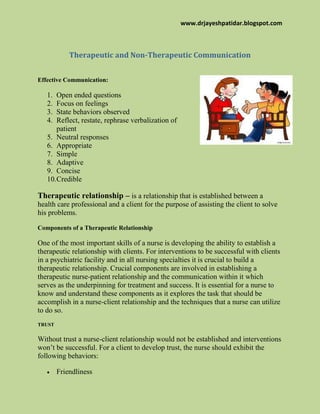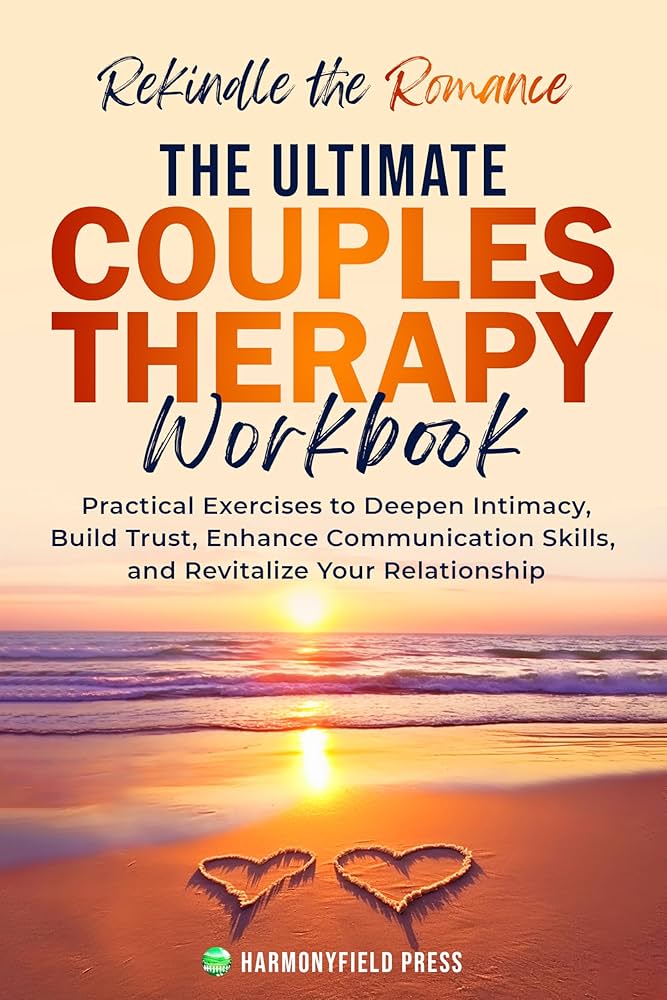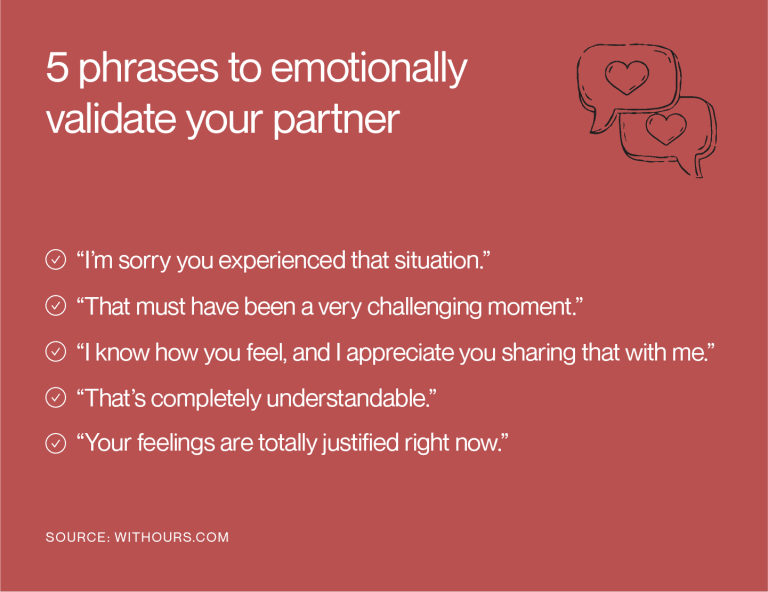Therapeutic Vs Normal Communication
Are you curious about the difference between therapeutic communication and normal communication? Well, let me tell you, it’s an interesting topic that can help you understand the power of effective communication. You see, therapeutic communication goes beyond the usual chit-chat. It’s a special way of talking and listening that healthcare professionals use to connect with their patients.
So, what sets therapeutic communication apart from everyday conversation? It’s all about the purpose and skill involved. Therapeutic communication focuses on promoting healing, building trust, and providing emotional support. It’s like a supercharged version of communication that can make a real difference in someone’s well-being.
In this article, we’ll explore the key differences between therapeutic communication and normal communication. We’ll delve into the unique techniques used in therapeutic communication and how they can positively impact the patient-provider relationship. Get ready to discover the power of words in creating a healing environment!
When it comes to communication, there are important differences between therapeutic communication and normal communication. Therapeutic communication focuses on creating a supportive and healing environment, while normal communication is more casual and everyday. Some key distinctions include active listening, empathy, and nonjudgmental attitudes. Therapeutic communication also involves open-ended questions and reflection, promoting self-awareness and growth. Understanding these differences can help improve relationships and facilitate healing in therapeutic settings.

Key Takeaways: Therapeutic Communication vs Normal Communication
- Therapeutic communication focuses on empathy and understanding.
- Normal communication is everyday conversation.
- Therapeutic communication is used in counseling or healthcare settings.
- Normal communication is used in daily interactions with friends and family.
- Therapeutic communication aims to promote healing and personal growth.
Comparing Therapeutic Communication vs Normal Communication
Therapeutic communication and normal communication are two different approaches to interacting with others. While normal communication focuses on everyday conversations and interactions, therapeutic communication is a specific technique used in healthcare and counseling settings to facilitate healing and promote positive relationships. In this article, we will explore the key differences between therapeutic communication and normal communication, and examine the benefits and limitations of each approach.
Overview of Therapeutic Communication
Therapeutic communication is a structured and intentional form of communication used by professionals such as nurses, therapists, and counselors to establish rapport, gain trust, and promote emotional well-being in their clients or patients. It involves active listening, empathy, and non-judgmental responses.
In therapeutic communication, the focus is on the individual’s feelings, thoughts, and experiences. The goal is to create a safe and supportive environment where individuals can express themselves freely and explore their emotions. Through therapeutic communication, professionals can help individuals gain insights, develop coping mechanisms, and work towards positive change.
Overview of Normal Communication
Normal communication, on the other hand, refers to everyday interactions and conversations that occur in various social settings. It involves exchanging information, expressing thoughts and feelings, and engaging in casual conversations. Unlike therapeutic communication, normal communication is not guided by specific techniques or goals.
Normal communication can occur between friends, family members, colleagues, and strangers. It is essential for building connections, maintaining relationships, and conveying information effectively. While it may not have the same level of attentiveness and intentionality as therapeutic communication, normal communication plays a crucial role in our daily lives.
Key Features Compared
In this section, we will compare the key features of therapeutic communication and normal communication to gain a better understanding of their differences.
Active Listening
In therapeutic communication, active listening is a fundamental skill. It involves fully engaging with the individual, showing interest, and providing verbal and non-verbal cues to demonstrate understanding. Active listening creates a safe space for individuals to share their feelings and concerns without fear of judgment.
In normal communication, active listening is also important, but it may not be as deliberate or focused. Everyday conversations often involve a back-and-forth exchange of information, where both parties listen and respond without specific therapeutic goals in mind.
Empathy and Non-Judgmental Attitude
Therapeutic communication emphasizes the importance of empathy and a non-judgmental attitude. Professionals practicing therapeutic communication strive to understand the individual’s perspective, emotions, and challenges without imposing their own biases or judgments. This creates a supportive environment where individuals feel validated and understood.
While empathy and non-judgmental attitudes are also beneficial in normal communication, they may not be as consciously employed. In normal conversations, people often express their opinions and judgments more freely, which can sometimes hinder effective communication.
Clarification and Reflection
In therapeutic communication, professionals often use clarification and reflection techniques to ensure that they have accurately understood the individual’s thoughts and feelings. Clarification involves asking questions to get more information, while reflection involves summarizing and restating the individual’s words to confirm understanding.
In normal communication, clarification and reflection techniques may not be as common or necessary. Everyday conversations typically flow naturally, and misunderstandings can be resolved through further discussion or clarification if needed.
User Experience
The user experience of therapeutic communication and normal communication can vary depending on the context and individuals involved.
In therapeutic communication, individuals seeking support or guidance from professionals often report positive experiences. They appreciate the non-judgmental environment and the opportunity to express their innermost thoughts and feelings without fear of repercussions. Therapeutic communication allows individuals to gain insights, resolve conflicts, and develop coping strategies, leading to enhanced emotional well-being.
In normal communication, the user experience can vary greatly. Positive experiences are often associated with open and honest conversations, where individuals feel heard, understood, and respected. However, negative experiences can occur when communication breaks down, leading to misunderstandings, conflicts, and hurt feelings.
Pros and Cons
Therapeutic Communication:
Pros:
– Provides a safe and non-judgmental environment for individuals to express themselves.
– Promotes emotional healing, self-reflection, and personal growth.
– Facilitates a strong therapeutic relationship between professionals and individuals seeking support.
Cons:
– Requires training and expertise to effectively practice therapeutic communication.
– May not be suitable or necessary for all communication contexts.
– Can be time-consuming, especially in situations where efficiency is a priority.
Normal Communication:
Pros:
– Facilitates everyday interactions and relationship building.
– Allows for quick and efficient exchange of information.
– Can be used in various contexts and with different individuals.
Cons:
– Lack of intentionality and focus on emotions and deeper understanding.
– Potential for misunderstandings and miscommunication.
– Does not have the same level of therapeutic benefits as therapeutic communication.
Price Comparison
Therapeutic communication and normal communication do not have direct monetary costs associated with them as they are approaches to communication rather than products or services. However, the use of therapeutic communication may require professionals to undergo training and ongoing education, which can incur financial costs.
Normal communication does not have specific costs associated with it, as it is a natural part of our daily lives. However, individuals may choose to invest in communication skills development or communication tools such as books or courses to enhance their communication abilities.
Comparison Table
Below is a comparison table highlighting the differences between therapeutic communication and normal communication in more detail:
Feature Therapeutic Communication Normal Communication
Active Listening Focused, deliberate, and attentive listening Listening is important but may not be as deliberate or focused
Empathy and Non-Judgmental Attitude Emphasizes empathy and a non-judgmental attitude Empathy and non-judgmental attitudes are beneficial but may not be consciously employed
Clarification and Reflection Utilizes clarification and reflection techniques to ensure understanding Clarification and reflection techniques may not be as common or necessary
Use of Techniques and Strategies Specific techniques and strategies are employed for healing and growth No specific techniques or strategies are required
Goal To facilitate healing, self-reflection, and personal growth To exchange information and engage in casual conversations
Which is Better – Therapeutic Communication vs Normal Communication?
Both therapeutic communication and normal communication serve important purposes in different contexts. The choice between the two depends on the specific goals and needs of the communication situation.
For individuals seeking support, guidance, or healing, therapeutic communication offers a structured approach that creates a safe and non-judgmental space for self-expression. It can lead to personal growth, emotional healing, and the development of coping strategies. Therapeutic communication is best suited for professional settings such as healthcare, counseling, or therapy, where trained professionals can provide the necessary support.
On the other hand, normal communication is essential for everyday interactions, building relationships, and exchanging information. It is versatile and can be used in various contexts, from casual conversations with friends to professional meetings. Normal communication allows for efficient communication and can promote understanding and connection when used effectively.
In conclusion, there is no one-size-fits-all answer to which form of communication is better, as it depends on the specific context and goals. Both therapeutic communication and normal communication have their strengths and limitations, and understanding these differences allows individuals to choose the most appropriate approach for each situation.
Reasons to choose therapeutic communication:
1. Need for professional support and guidance in a safe and non-judgmental environment.
2. Desire for personal growth, self-reflection, and emotional healing.
3. Seek therapeutic relationships with trained professionals who can provide specialized support.
Reasons to choose normal communication:
1. Everyday conversations and interactions that do not require structured techniques.
2. Need for efficient and quick information exchange without therapeutic goals.
3. Building connections and maintaining relationships in various social settings.
Frequently Asked Questions
In the world of communication, there are different approaches based on the context and purpose. Two such approaches are therapeutic communication and normal communication. Here are some frequently asked questions about therapeutic communication and how it differs from normal communication.
Q: How does therapeutic communication differ from normal communication?
Therapeutic communication is a purposeful form of communication that focuses on promoting healing, growth, and positive change in a person. It is used mainly in therapeutic settings, such as counseling or healthcare, to establish a safe and supportive environment for clients or patients. Normal communication, on the other hand, refers to everyday conversation and interactions without a specific therapeutic goal or intention.
In therapeutic communication, the focus is on active listening, empathy, and open-ended questions to encourage individuals to explore their thoughts, feelings, and experiences. It involves creating a non-judgmental space where the person feels understood and supported. Normal communication, in contrast, often serves practical purposes, such as exchanging information or engaging in casual conversation.
Q: What are the key skills involved in therapeutic communication?
Therapeutic communication relies on various skills to establish a therapeutic alliance and facilitate effective communication. Active listening is a fundamental skill, where the listener fully engages with the speaker, demonstrates empathy, and provides verbal and non-verbal cues to show understanding. Reflective listening, which involves paraphrasing or summarizing the speaker’s words, helps clarify understanding and encourages further exploration of thoughts and feelings.
Another crucial skill is using open-ended questions that encourage individuals to delve deeper into their experiences and emotions. These questions can begin with phrases like “tell me more about…” or “what was that like for you?” Additionally, providing reassurance, showing empathy, and being non-judgmental are essential elements of therapeutic communication.
Q: In what contexts is therapeutic communication commonly used?
Therapeutic communication is frequently employed in various therapeutic settings, such as counseling, psychotherapy, nursing, social work, and healthcare. Mental health professionals use therapeutic communication techniques to establish rapport, explore emotions, and facilitate the healing process. In healthcare, it is used by nurses, doctors, and other healthcare professionals to promote patient-centered care and enhance the patient’s overall experience.
Moreover, anyone can apply therapeutic communication skills in their personal relationships, as it fosters healthy and supportive interactions. It can be beneficial for individuals who want to improve their listening skills, demonstrate empathy, and create a safe and validating space for others to express themselves.
Q: Can therapeutic communication be used in everyday interactions?
While therapeutic communication techniques are commonly used in therapeutic settings, the skills can also be applied in everyday interactions. The key is to adapt the techniques to the context and the individuals involved. Active listening and empathy, for example, can enhance communication in personal relationships, friendships, and professional settings.
By being fully present, listening attentively, and responding with empathy, individuals can establish deeper connections and build trust. Showing understanding and support, using open-ended questions, and being non-judgmental can create a safe and supportive environment for meaningful conversations, even in everyday interactions.
Q: Is therapeutic communication always formal and serious?
While therapeutic communication is often associated with formal therapeutic settings and serious topics, it doesn’t always have to be formal or serious. The key is the therapeutic intention behind the communication. Even in casual conversations, individuals can apply active listening, empathy, and open-ended questions to foster better understanding and connection.
Therapeutic communication skills can be used to support friends during difficult times, navigate conflicts in a constructive manner, or simply express empathy and understanding to others. By incorporating therapeutic communication principles into everyday interactions, individuals can enhance their relationships and create a more positive and supportive environment.

Summary
So, let’s sum up what we’ve learned about therapeutic communication and normal communication. Therapeutic communication is a way of talking that helps people feel better and understood when they are going through tough times. It involves being a good listener, showing empathy, and using open-ended questions to encourage people to express their feelings.
On the other hand, normal communication is what we use in everyday conversations. It’s important to remember that not all conversations require therapeutic communication. Sometimes, we just want to chat casually or share information without delving deep into emotions.
Therapeutic communication is a powerful tool for nurses, psychologists, and even friends and family members who want to support someone who is struggling. It helps build trust, creates a safe space for sharing, and promotes emotional healing. However, we should recognize that therapeutic communication should be used with care, as professionals are trained to handle deep emotions.
In our daily lives, we can still apply some of the techniques of therapeutic communication to enhance our relationships and support our loved ones when they need us. Listening actively, showing empathy, and providing a non-judgmental environment are important aspects of being there for someone.
Remember, communication is not just about speaking but also about listening. By practicing therapeutic communication, we can become better at understanding and connecting with others. So, whenever someone comes to you with a problem, try using some of the techniques we learned today, and you might be surprised by the positive impact it can have on their well-being.


